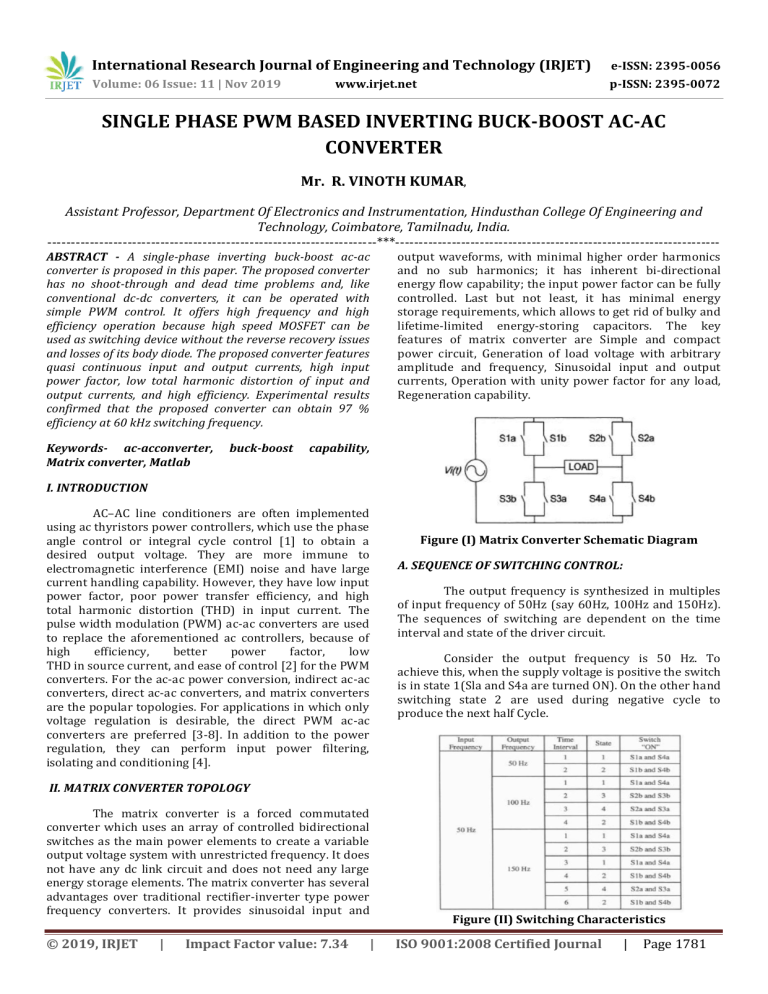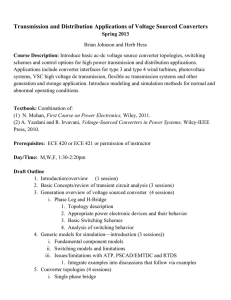IRJET-Single Phase PWM based Inverting Buck-Boost AC-AC Converter
advertisement

International Research Journal of Engineering and Technology (IRJET) e-ISSN: 2395-0056 Volume: 06 Issue: 11 | Nov 2019 p-ISSN: 2395-0072 www.irjet.net SINGLE PHASE PWM BASED INVERTING BUCK-BOOST AC-AC CONVERTER Mr. R. VINOTH KUMAR, Assistant Professor, Department Of Electronics and Instrumentation, Hindusthan College Of Engineering and Technology, Coimbatore, Tamilnadu, India. ----------------------------------------------------------------------***--------------------------------------------------------------------ABSTRACT - A single-phase inverting buck-boost ac-ac converter is proposed in this paper. The proposed converter has no shoot-through and dead time problems and, like conventional dc-dc converters, it can be operated with simple PWM control. It offers high frequency and high efficiency operation because high speed MOSFET can be used as switching device without the reverse recovery issues and losses of its body diode. The proposed converter features quasi continuous input and output currents, high input power factor, low total harmonic distortion of input and output currents, and high efficiency. Experimental results confirmed that the proposed converter can obtain 97 % efficiency at 60 kHz switching frequency. Keywords- ac-acconverter, Matrix converter, Matlab buck-boost output waveforms, with minimal higher order harmonics and no sub harmonics; it has inherent bi-directional energy flow capability; the input power factor can be fully controlled. Last but not least, it has minimal energy storage requirements, which allows to get rid of bulky and lifetime-limited energy-storing capacitors. The key features of matrix converter are Simple and compact power circuit, Generation of load voltage with arbitrary amplitude and frequency, Sinusoidal input and output currents, Operation with unity power factor for any load, Regeneration capability. capability, I. INTRODUCTION AC–AC line conditioners are often implemented using ac thyristors power controllers, which use the phase angle control or integral cycle control [1] to obtain a desired output voltage. They are more immune to electromagnetic interference (EMI) noise and have large current handling capability. However, they have low input power factor, poor power transfer efficiency, and high total harmonic distortion (THD) in input current. The pulse width modulation (PWM) ac-ac converters are used to replace the aforementioned ac controllers, because of high efficiency, better power factor, low THD in source current, and ease of control [2] for the PWM converters. For the ac-ac power conversion, indirect ac-ac converters, direct ac-ac converters, and matrix converters are the popular topologies. For applications in which only voltage regulation is desirable, the direct PWM ac-ac converters are preferred [3-8]. In addition to the power regulation, they can perform input power filtering, isolating and conditioning [4]. Figure (I) Matrix Converter Schematic Diagram A. SEQUENCE OF SWITCHING CONTROL: The output frequency is synthesized in multiples of input frequency of 50Hz (say 60Hz, 100Hz and 150Hz). The sequences of switching are dependent on the time interval and state of the driver circuit. Consider the output frequency is 50 Hz. To achieve this, when the supply voltage is positive the switch is in state 1(Sla and S4a are turned ON). On the other hand switching state 2 are used during negative cycle to produce the next half Cycle. II. MATRIX CONVERTER TOPOLOGY The matrix converter is a forced commutated converter which uses an array of controlled bidirectional switches as the main power elements to create a variable output voltage system with unrestricted frequency. It does not have any dc link circuit and does not need any large energy storage elements. The matrix converter has several advantages over traditional rectifier-inverter type power frequency converters. It provides sinusoidal input and © 2019, IRJET | Impact Factor value: 7.34 Figure (II) Switching Characteristics | ISO 9001:2008 Certified Journal | Page 1781 International Research Journal of Engineering and Technology (IRJET) e-ISSN: 2395-0056 Volume: 06 Issue: 11 | Nov 2019 p-ISSN: 2395-0072 www.irjet.net Figure (III) Block Diagram Figure (V) Overall Hardware III. AC-AC CONVERTER MODULE Main model of SPMC consists of bidirectional switch module and driver circuits. The multiplier unit in the driver circuit is used to vary the magnitude of the sampled sinusoidal reference signal in order to change the modulation index of the SPWM. The modulation index input data is in the form of and integer ranging from 1 to 10. The output from the multiplier unit will then be used to compare with the carrier signal, thus producing the required SPWM switching signal. The hardware realization of the PWM based ACAC converter module is controlled by Arduino Uno. Here a lamp load is used for the visual display of the ac voltage characteristics. A potentiometer is attached to the arduino board and the frequency characteristics are noted using a DSO. For the varying frequency the voltage is modulated. IV. SIMUALTION The MATLAB model of the SPMC was developed by using the sim power system block set. Bidirectional switch module is developed by interconnecting two IGBT’s. Computer simulation of SPMC is done using MATLAB SIMULINK and the corresponding results for R and RL load are obtained. Simulation parameters are explained in the table. Figure shows the developed model for SPMC by using MLS that performs the operation of a direct AC-AC converter. (iii) (iv) Figure (VI) Simulink Block Diagram Figure (III) & (IV) Modulated voltage Characteristics © 2019, IRJET | Impact Factor value: 7.34 | ISO 9001:2008 Certified Journal | Page 1782 International Research Journal of Engineering and Technology (IRJET) e-ISSN: 2395-0056 Volume: 06 Issue: 11 | Nov 2019 p-ISSN: 2395-0072 www.irjet.net VII. REFERENCES [1] B. W. Williams, “Asymmetrically modulated AC chopper,” IEEE Trans. Ind. Electron., vol. 29, pp. 181–185, June 1982. [2] P. N. Enjeti and C. Sewan, “An approach to realize higher power PWM AC controller,” in Proc. 8th Annu. Appl. Power Electron. Conf. Expo., 1993, pp. 323–327. [3] J. Kolar, T. Friedli, J. Rodriguez, and P. Wheeler, “Review of three-phase PWM AC–AC converter topologies,” IEEE Trans. Ind. Electron., vol. 58, no. 11, pp. 4988–5006, Nov. 2011. Figure (VII) Low Frequency Output Voltage Graph [4] F. Z. Peng, L. Chen, and F. Zhang, “Simple topologies of PWM ac–ac converters,” IEEE Power Electron. Lett., vol. 1, no. 1, pp. 10–13, Mar. 2003. [5] Abdollah Koei & Subbaraya Yuvarajan, "SinglePhase AC-AC converter Using Power Mosfet's," IEEE Transaction on industrial Electronics, Vol. 35, No.3, August 1988, pp.442-443. [6] Biaajjerg F, Casadei D, Klumpner C, and Matteini, “Comparision of two current modulation strategies for matrix converters under unbalanced input voltage conditions,” IEEE Transactions on Industrial Electronics, Vol.49, April 2002, pp 289 – 296. Figure (VIII) High Frequency Output Voltage V. SIMULATION RESULTS The SPMC was simulated with switching strategy being implemented on all the four states and the results of SPMC model are done for 60Hz, 100Hz, 150Hz, that were synthesized from a supply operating at fundamental frequency of 60Hz. The simulation model could be used to study the behavior of the SPMC as an AC-AC converter under a variety of operating conditions, including different reference frequency. [7] Cho, J.G., and Cho, G.H., “ Soft-switched Matrix Converters for High Frequency direct AC to AC Power Conversions,” Int, J.Electron., 1992, 72,(4), pp. 669 – 680. [8] Firdaus,S., Hamzah, M.K., “Modelling and Simulation of a single-phase AC-AC matrix converter usig SPWM”, Proceedings on Student Conference on Research and Development, 16-17 July 2002, pp. 286 – 289. VI. CONCLUSION The designed converter has no shoot-through and dead time problems and, like conventional dc-dc converters, it can be operated with simple PWM control. It offers high frequency and high efficiency operation because high speed MOSFET can be used as switching device without the reverse recovery issues and losses of its body diode. Experimental results confirmed that the proposed converter can obtain 97% efficiency at 60 kHz switching frequency. These simulated results of SPMC illustrates that it is feasible to realize the matrix converter as a frequency step-up converter. Further works are required to implement low-pass filter at the output to ensure continuous waveforms that are desirable in actual applications. Also when using with RL load, Undesirable spikes seem to appear with a reasonable degree of magnitude that requires elimination. This probably could be solved using novel commutation strategies. © 2019, IRJET | Impact Factor value: 7.34 | ISO 9001:2008 Certified Journal | Page 1783


